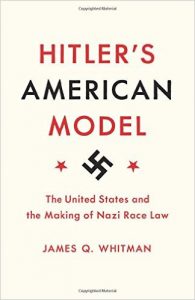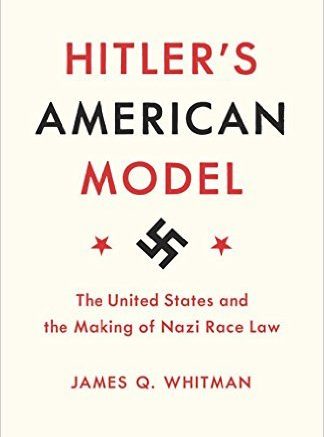
By David Swanson
WarIsACrime.org (4/21/17)
James Q. Whitman’s new book is called Hitler’s American Model: The United States and the Making of Nazi Race Law. It is understated and overdocumented, difficult to argue with. No doubt some will try.
In cartoonish U.S. historical understanding, the United States is, was, and ever shall be a force for good, whereas Nazism arose in a distant, isolated land that lacked any connection to other societies. In a cartoonish reversal of that understanding that would make a good strawman for critics of this book, U.S. policies have been identical to Nazism which simply copied them. Obviously this is not the case.
In reality, as we have long known, the U.S. genocide of Native Americans was a source of inspiration in Nazi discussions of expanding to their east, even referring to Ukrainian Jews as “Indians.” Camps for Native Americans helped inspire camps for Jews. Anti-Semites and eugenicists and racists in the U.S. helped inspire those in Germany, and vice versa. U.S. bankers invested in the Nazis. U.S. weapons dealers armed them. Nazis borrowed from U.S. propaganda techniques developed in World War I. Admirers in the U.S. of Nazi Germany and fascist Italy attempted at least one coup against President Franklin Roosevelt. The U.S. refused to admit significant numbers of Jewish refugees or to help evacuate them from Germany. The State Department turned down Anne Frank’s visa. The coast guard chased a ship of Jews away, sending them back to their fate. Et cetera. We have known all of this.
In 1935, a week after Hitler had proclaimed the Nuremberg Laws, a group of Nazi lawyers sailed to New York to study U.S. law. There, they were protested by Jews but hosted by the New York City Bar Association.
We have known how the U.S. treated African Americans, Japanese Americans, and others at the time of World War II, how it experimented on Guatemalans even during the trials of Nazis for human experimentation, and continued to allow human experimentation in the U.S. for many years. And so forth. The good versus evil cartoon was never real.
What Whitman’s book adds to the complex story is an understanding of U.S. influences on the drafting of Nazi race laws. No, there were no U.S. laws in the 1930s establishing mass murder by poison gas in concentration camps. But neither were the Nazis looking for such laws. Nazis lawyers were looking for models of functioning laws on race, laws that effectively defined race in some way despite the obvious scientific difficulties, laws that restricted immigration, citizenship rights, and inter-racial marriage. In the early 20th century the recognized world leader in such things was the United States.
Whitman quotes from the transcripts of Nazi meetings, internal documents, and published articles and books. There is no doubt of the role that U.S. (state, not just federal) legal models played in the development of the Nuremberg Laws. The 1930s was a time, we should recall, when Jews in Germany and primarily African Americans in the United States were lynched. It was also a time when U.S. immigration laws used national origin as a means of discrimination — something Adolf Hitler praised in Mein Kampf. It was a time of de facto second-class citizenship in the United States for blacks, Chinese, Filipinos, Puerto Ricans, Japanese, and others. Thirty U.S. states had systems of laws banning interracial marriage of various sorts — something the Nazis could find nowhere else and studied in comprehensive detail, among other things for the examples of how the races were defined. The U.S. had also shown how to conquer territories of undesirables, such as in the Philippines or Puerto Rico, and incorporate them into an empire but not give first-class citizenship rights to the residents. Up until 1930 a U.S. woman could lose her citizenship if she married a non-citizen Asian man.
Even the Nazis hesitated over some US laws
The most radical of the Nazis, not the moderates, in their deliberations were the advocates for the U.S. models. But even they believed some of the U.S. systems simply went too far. The “one-drop” rule for defining a colored person was considered too harsh, for example, as opposed to defining a Jew as someone with three or more Jewish grandparents (how those grandparents were defined as Jewish is another matter; it was the willingness to ignore logic and science in all such laws that was most of the attraction). The Nazis also defined as Jewish someone with only two Jewish grandparents who met other criteria. In this broadening the definition of a race to things like behavior and appearance, the U.S. laws were also a model.
One of many U.S. state laws that Nazis examined was this from Maryland:
“All marriages between a white person and a Negro, or between a white person and a person of Negro descent, to the third generation, inclusive, or between a white person and a member of the Malay race or between a Negro and a member of the Malay race, or between a person of Negro descent to the third generation, inclusive, and a member of the Malay race . . . [skipping over many variations] . . . are forever prohibited . . . punished by imprisonment in the penitentiary for not less than eighteen months nor more than ten years.”
The Nazis of course examined and admired the Jim Crow laws of segregation as well but determined that such a regime would only work against an impoverished oppressed group. German Jews, they reasoned, were too rich and powerful to be segregated. Some of the Nazi lawyers in the 1930s, before Nazi policy had become mass murder, also found the extent of the U.S. segregation laws too extreme. But Nazis admired racist statements from contemporary U.S. pundits and authorities back at least to Thomas Jefferson. Some argued that because segregation was de facto established in the U.S. South despite a Constitution mandating equality, this proved that segregation was a powerful, natural, and inevitable force. In other words, U.S. practice allowed Nazis to more easily think of their own desired practices in the early years of their madness as normal. …
*****
Amazon Review: How American Race Law Provided The Blueprint For Nazi Germany
Nazism triumphed in Germany during the high era of Jim Crow laws in the United States. Did the American regime of racial oppression in any way inspire the Nazis? The unsettling answer is yes. In Hitler’s American Model, James Whitman presents a detailed investigation of the American impact on the notorious Nuremberg Laws, the centerpiece anti-Jewish legislation of the Nazi regime. Contrary to those who have insisted that there was no meaningful connection between American and German racial repression, Whitman demonstrates that the Nazis took a real, sustained, significant, and revealing interest in American race policies.
As Whitman shows, the Nuremberg Laws were crafted in an atmosphere of considerable attention to the precedents American race laws had to offer. German praise for American practices, already found in Hitler’s Mein Kampf, was continuous throughout the early 1930s, and the most radical Nazi lawyers were eager advocates of the use of American models. But while Jim Crow segregation was one aspect of American law that appealed to Nazi radicals, it was not the most consequential one. Rather, both American citizenship and antimiscegenation laws proved directly relevant to the two principal Nuremberg Laws–the Citizenship Law and the Blood Law. Whitman looks at the ultimate, ugly irony that when Nazis rejected American practices, it was sometimes not because they found them too enlightened, but too harsh.
Indelibly linking American race laws to the shaping of Nazi policies in Germany, Hitler’s American Model upends understandings of America’s influence on racist practices in the wider world.

